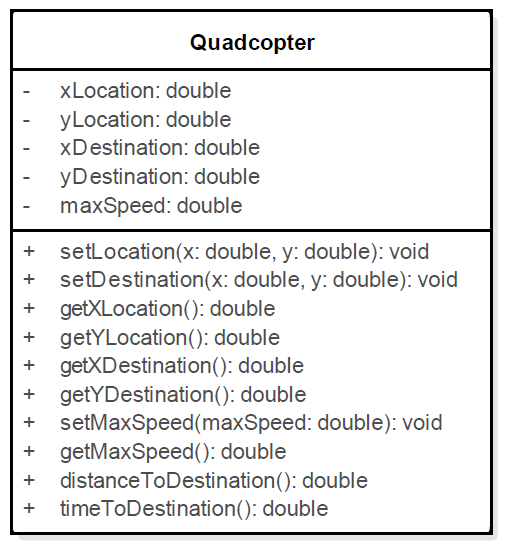
The corresponding class:
public class Quadcopter
{
private double xLocation, yLocation, xDestination, yDestination;
private double maxSpeed;
public void setLocation(double x, double y)
{
xLocation = x;
yLocation = y;
}
public void setDestination(double x, double y)
{
xDestination = x;
yDestination = y;
}
public double getXDestination()
{
return xDestination;
}
public double getYDestination()
{
return yDestination;
}
public void setMaxSpeed(double maxSpeed)
{
this.maxSpeed = maxSpeed;
}
public void getMaxSpeed()
{
return maxSpeed;
}
public double distanceToDestination()
{
double dx = xLocation - xDestination;
double dy = yLocation - yDestination;
double dist = Math.sqrt(dx * dx + dy * dy);
return dist;
}
public double timeToDestination()
{
double distToTravel = distanceToDestination();
double time = distToTravel / maxSpeed;
return time;
}
}
- Suppose we rewrite setLocation as follows:
// WRONG!! public void setLocation(double x, double y) { double xLocation = x; double yLocation = y; }- Each time introduce braces, get a new "context"
- Known as a block
- scope: area where data is visible
- within methods, scope is from point of declaration to end of enclosing block
- cannot declare variable twice with same scope - illegal:
public double dist() { double d = xLocation - xDestination; double d = yLocation - yDestination; ... }but could write something likepublic double dist() { if ( xLocation > yLocation ) { double d = xLocation - xDestination; ... } else { double d = yLocation - yDestination; ... } } - Variables within a method are said to be local
- Parameters are effectively declared from the beginning of the method to the end
- Each time introduce braces, get a new "context"
- Can return from anywhere in a method:
public double timeToDestination() { if ( maxSpeed < 1e-4 ) { // force VERY long time to get there return distToTravel / 1e-30; } double distToTravel = distanceToDestination(); double time = distToTravel / maxSpeed; return time; }- This is rare - generally have just one return
- Note void methods can also have returns:
public void setMaxSpeed(double maxSpeed) { if ( maxSpeed < 0.0 ) { System.err.println("Illegal max speed."); return; } this.maxSpeed = maxSpeed; }- Also to be avoided!